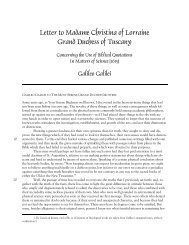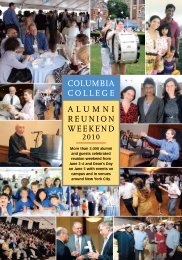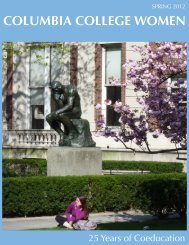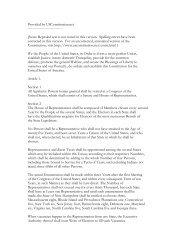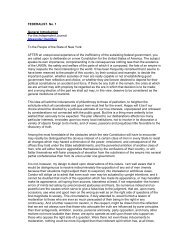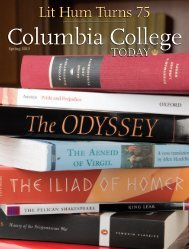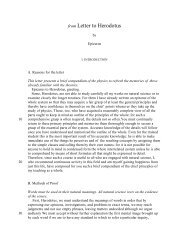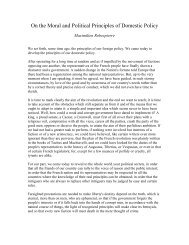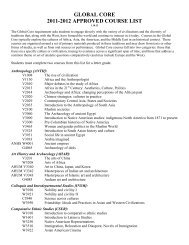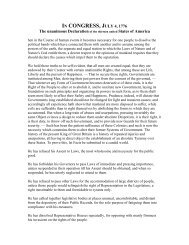Download this issue as a PDF - Columbia College - Columbia ...
Download this issue as a PDF - Columbia College - Columbia ...
Download this issue as a PDF - Columbia College - Columbia ...
Create successful ePaper yourself
Turn your PDF publications into a flip-book with our unique Google optimized e-Paper software.
HURRICANE SANDY<br />
COLUMBIA COLLEGE TODAY<br />
COLUMBIA COLLEGE TODAY<br />
“I spent the whole break taking the front end off one car with a<br />
ratchet set and putting it on the other car. It w<strong>as</strong> mechanical, finger-banging,<br />
hand-scrapping, back-breaking work,” he says. “I remember<br />
thinking, ‘This isn’t for me.’ I knew I had to throw myself<br />
100 percent into education.”<br />
He w<strong>as</strong> hired full-time <strong>as</strong> a fifth-grade teacher at P.S. 236 Mill<br />
B<strong>as</strong>in in Brooklyn in 1992 and rose to <strong>as</strong>sistant principal in 2000.<br />
But that December, he found himself “in a funk,” having lost out<br />
on a principalship. He turned to technology, always his hobbyhorse,<br />
and started videotaping his best teachers in action in the<br />
cl<strong>as</strong>sroom. On staff development days, he showed the videos to<br />
staff, and the highlighted teacher would present on how his or<br />
her style worked.<br />
In April 2003, O’Connell w<strong>as</strong> promoted to principal of Belle<br />
Harbor School, the elementary school where he realized just how<br />
few Rockaway students stayed in the Rockaways for middle and<br />
high school. That summer he w<strong>as</strong> tapped by C<strong>as</strong>hin and started<br />
on what he calls “the dog and pony show of selling a school.”<br />
He pitched the district and the community the idea of a gifted<br />
middle school program that could retain the peninsula’s best and<br />
brightest.<br />
Scholars’ Academy opened in 2004 <strong>as</strong> a sixth-grade middle<br />
school program, with the students divided between two locations<br />
in E<strong>as</strong>t New York. A year later the staff and students moved<br />
into a permanent home, which they shared with a struggling<br />
local high school, P.S. 180. By 2006 Scholars’ had morphed into<br />
a full middle school, hosting grades six through eight. In 2007,<br />
b<strong>as</strong>ed on community response, it expanded into an accelerated<br />
high school program by adding one grade a year until 2011, when<br />
its first senior cl<strong>as</strong>s graduated. P.S. 180 w<strong>as</strong> eventually ph<strong>as</strong>ed out<br />
and Scholars’ Academy h<strong>as</strong> since earned straight A’s on its NYC<br />
Department of Education Progress Reports for both the middle<br />
and high schools.<br />
If you found yourself in a Scholars’ cl<strong>as</strong>sroom today and<br />
thought you’d wandered onto the set of Star Trek, you couldn’t be<br />
faulted. Technology is one of O’Connell’s core interests, and using<br />
it to enhance the cl<strong>as</strong>sroom experience w<strong>as</strong> a founding tenet<br />
of the school. It shows. There’s more technology packed into the<br />
700-sq.-ft. rooms than your typical Apple store. The white boards<br />
are digital — three, four, sometimes five to a room. All the administrators<br />
and teachers carry iPads. There are carts with dozens<br />
of iPads and Kindles for the students to use. There are few textbooks<br />
and no paper. Every lesson is posted online and beamed<br />
to the walls and the tablets. Parents have logins to the school’s<br />
website and can track their children’s progress.<br />
The curriculum is built around the SCALE-UP model, which<br />
places students at round tables, not desks, in “learning triads” or<br />
“cooperative learning groups” to encourage collaborative learning<br />
and team problem solving. “It’s about promoting interdisciplinary<br />
learning, where it fits,” C<strong>as</strong>hin says. “We created a strong framework<br />
with lots of reading, fiction and nonfiction, a lot of writing<br />
and a lot of project-oriented learning. Brian took that framework<br />
and moved it to a new level. He’s so talented, so intelligent that he<br />
saw how technology can reach out to parents, enhance communication<br />
and heighten integration in the cl<strong>as</strong>sroom.”<br />
Approximately 25 percent of Scholars’ Academy students<br />
come from e<strong>as</strong>t Rockaway peninsula, which is predominantly<br />
black and Latino, and another 25 percent come from the west<br />
peninsula, which is primarily white. Roughly 40 percent of the<br />
students come from District 27, which makes up the outer edge<br />
of Queens. Ten percent come from elsewhere in the city, some <strong>as</strong><br />
far away <strong>as</strong> Park Slope in Brooklyn and Forest Hills in Queens.<br />
“The school is literally smack in the middle of the peninsula,”<br />
O’Connell says, thumping a map of the Rockaways on his office<br />
wall. Despite the technology and all the innovative learning strategies,<br />
he considers the central mission of Scholars’ Academy “positive<br />
integration” in the middle of a socially, economically and religiously<br />
diverse community. “The round tables are about equity,”<br />
he says. “The triads are about social cooperation.”<br />
“We lost our home. We lost our business. Eight<br />
feet of water covered everything,” says Lintia<br />
Lyons, whose sixth-grade son, Caleb,<br />
had just received his Outstanding Scholar<br />
certificate from O’Connell. After the storm, the family bounced<br />
from a Hilton to a friend’s home to staying with family to a rental<br />
near their property so they could continue down the long road of<br />
reconstruction.<br />
Such stories were typical among Scholars’ families and many<br />
others across the city, and NYC public schools shut down for an<br />
unprecedented five days after the storm. When they reopened,<br />
O’Connell’s students were displaced out and around the five boroughs.<br />
With the help of Google Docs and cell phone contact with<br />
parents, his <strong>as</strong>sistant principals pinpointed the neighborhoods<br />
with the highest densities of Scholars’ students. They set up charter<br />
bus depots to transport kids from those neighborhoods to<br />
temporary schools in E<strong>as</strong>t New York. “I didn’t even know how<br />
we’d pay for it,” O’Connell says. “But I figured, hey, that’s what<br />
FEMA is for.” (FEMA did come through with some funding.)<br />
Yet the night before that first day back, a major miscommunication<br />
occurred. The NYC Department of Education sent a notice<br />
to parents to have their kids at the Scholars’ Academy site to meet<br />
district busses, not at the bus depots the Scholars’ staff had set up<br />
and already communicated about to parents.<br />
O’Connell drove to Scholars’ that morning from the Bay Ridge<br />
hotel where he’d been living with his wife and children since the<br />
storm. Fourteen students had shown up at the school (the majority<br />
had gone to the bus depots anyway). It w<strong>as</strong> freezing. A nor’e<strong>as</strong>ter<br />
w<strong>as</strong> approaching the city.<br />
“I got on the bus with them and <strong>as</strong>ked, ‘How many of you<br />
have electricity’” he recalls. Not a single hand went up. “How<br />
many of you have heat” Not a single hand. “How many of you<br />
have hot water” Not a single hand. “How many of you want to<br />
go to school” Every hand on the bus shot up.<br />
All told, Sandy displaced 30 percent of the school’s staff and 60<br />
percent of its 1,200 students. The Department of Education committed<br />
$200 million to repair the flooded and broken building but<br />
even with such funding the work w<strong>as</strong> slow. Demolition teams<br />
brought down walls, chiseled away the rotted gym floor and collected<br />
all the school’s tr<strong>as</strong>hed paper records in a cargo container<br />
by the front door. For their part, the parents, students and teachers<br />
worked just <strong>as</strong> hard, bearing down on the work of teaching<br />
and learning in their temporary E<strong>as</strong>t New York schools.<br />
Four months later, when the kids finally moved back into the<br />
Rockaway Park school building that had become a home away<br />
from home for so many, O’Connell handed them all T-shirts. On<br />
the front, it read “Scholars Strong,” and on the back, “Rockaway<br />
Resilient.”<br />
For more photos of and to view a video about Hurricane Sandy’s impact<br />
on Scholars’ Academy, go to Web Extr<strong>as</strong> at college.columbia.edu/cct.<br />
Michael R. Shea ’10 Arts is a freelance writer who lives in New York<br />
City.<br />
Alumni<br />
News<br />
58 Message from the<br />
CCAA President<br />
59 Bookshelf<br />
61 Obituaries<br />
64 Cl<strong>as</strong>s Notes<br />
112 Alumni Corner<br />
Members of the c<strong>as</strong>t of the 1940<br />
Varsity Show, called Life Begins<br />
in ’40, take advantage of beautiful<br />
weather on March 20, 1940, to<br />
rehearse on Low Plaza. Their dance<br />
routine, “Pony Ballet,” included<br />
student-athletes with a combined<br />
weight of more than two tons.<br />
Life Begins in ’40 w<strong>as</strong> written by<br />
famed Varsity Show alumnus I.A.L.<br />
Diamond ’41, who went on to write<br />
Some Like It Hot (1959) and The<br />
Apartment (1960) with Billy Wilder.<br />
PHOTO: WIDE WORLD PHOTOS, INC.,<br />
COURTESY COLUMBIA UNIVERSITY<br />
ARCHIVES<br />
SUMMER 2013<br />
56<br />
SUMMER 2013<br />
57




